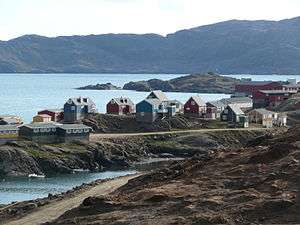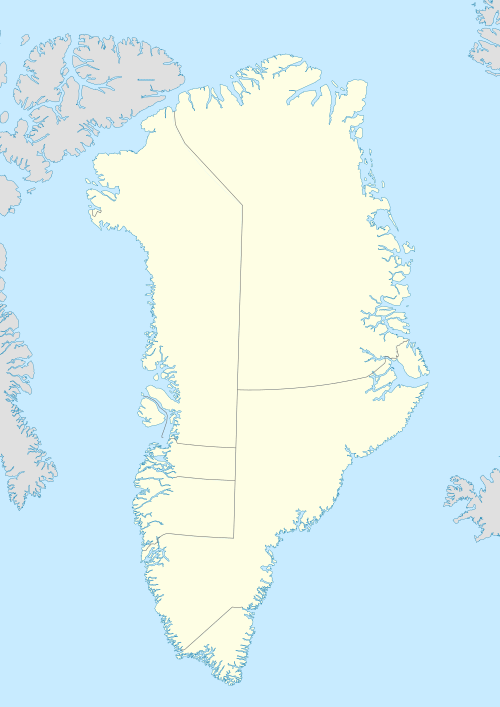Tasiilaq
Tasiilaq, formerly Ammassalik and Angmagssalik, is a town in the Sermersooq municipality in southeastern Greenland. With 1,985 inhabitants as of 2020,[1] it is the most populous community on the eastern coast, and the seventh-largest town in Greenland. The Sermilik Station, dedicated to the research of the nearby Mittivakkat Glacier, is located near the town.
Tasiilaq Pedograd | |
|---|---|
 Tasiilaq | |
 Tasiilaq Location within Greenland | |
| Coordinates: 65°36′49″N 37°37′52″W | |
| State | |
| Constituent country | |
| Municipality | |
| Founded | 1894 |
| Population (2020) | |
| • Total | 1,985[1] |
| Time zone | UTC-03 |
| Postal code | 3913 |
History
Prehistory to the fifteenth century
The people of Saqqaq culture were the first to reach eastern Greenland, arriving from the north,[2] through what is now known as Peary Land and Independence Fjord, to be surpassed by the Dorset culture. The Norse would have been familiar with the area as the first landmark on the voyage between Iceland's Snæfellsnes peninsula and Greenland. Thule migrations passed through the area in the fifteenth century,[2] finding the southeastern coast uninhabited.
Eighteenth and nineteenth centuries

Due to back migrations to the more densely populated western coast, the southeastern coast was deserted for another two hundred years−the region wasn't settled until late eighteenth century,[3] with the village surviving as the only permanent settlement in the nineteenth century. Population increased however from the 1880s, dispersing over several villages in the area.
The permanent settlement was founded in 1894[4] as a Danish trading station.[5] The town was previously known as Ammassalik (old spelling: Angmagssalik). The official name change took place in 1997.
Geography
Tasiilaq is located approximately 106 km (65.9 mi) south of the Arctic Circle, on the southeastern coast of Ammassalik Island, on the shore of a natural harbour in Tasiilaq Fjord,[6] named Kong Oscars Havn[5] by Alfred Gabriel Nathorst in 1883. The fjord is an inlet of the long Ammassalik Fjord emptying into the North Atlantic to the east of the town. The large Sermilik Fjord lies further to the west.
Population
With 1,985 inhabitants as of 2020, Tasiilaq is one of the fastest-growing towns in Greenland,[1] with migrants from the smaller towns and settlements reinforcing the trend. Together with Nuuk, it is the only town in the Sermersooq municipality exhibiting stable growth patterns over the last two decades. The population increased by over 37% relative to the 1990 levels, and by over 18% relative to the 2000 levels.[1]
Language
Tasiilaq is the main location where East Greenlandic is spoken.
Transport
There are no roads far outside Tasiilaq. The longest is a 3 km narrow gravel road to the hydro power plant. Transport to further places is by helicopter or boat.
Air
Air Greenland operates helicopter services from Tasiilaq Heliport to neighboring Kulusuk Airport (24 km/15 mi away), which offers connections to Nuuk, Ittoqqortoormiit via Nerlerit Inaat Airport, and to Iceland.[7] The heliport serves as a local helicopter hub with flights to several villages in the region: Isortoq, Kuummiit, Sermiligaaq, and Tiniteqilaaq.[7]
Sea
In the summer, the cargo boats of Royal Arctic Line connect Tasiilaq with Kulusuk,[8] providing an ad-hoc alternative for the helicopter flights of Air Greenland.[5]
Climate
Tasiilaq has a tundra climate, with long, cold and snowy winters and short, cool drier summers. From time to time, Tasiilaq is affected by piteraqs. On 6 February 1970 the worst piteraq ever documented hit Tasiilaq, causing heavy damage and nearly ruining the town.[9]
| Climate data for Tasiliaq (1981-2010 normals) | |||||||||||||
|---|---|---|---|---|---|---|---|---|---|---|---|---|---|
| Month | Jan | Feb | Mar | Apr | May | Jun | Jul | Aug | Sep | Oct | Nov | Dec | Year |
| Record high °C (°F) | 9.8 (49.6) |
15.2 (59.4) |
15.1 (59.2) |
15.2 (59.4) |
17.9 (64.2) |
25.3 (77.5) |
25.2 (77.4) |
25.2 (77.4) |
21.2 (70.2) |
19.3 (66.7) |
21.6 (70.9) |
12.2 (54.0) |
25.3 (77.5) |
| Average high °C (°F) | −4.0 (24.8) |
−4.0 (24.8) |
−3.6 (25.5) |
0.4 (32.7) |
4.0 (39.2) |
7.9 (46.2) |
10.3 (50.5) |
9.9 (49.8) |
6.7 (44.1) |
2.2 (36.0) |
−0.9 (30.4) |
−2.7 (27.1) |
2.2 (35.9) |
| Daily mean °C (°F) | −6.8 (19.8) |
−7.1 (19.2) |
−7.0 (19.4) |
−3.3 (26.1) |
0.9 (33.6) |
4.4 (39.9) |
6.6 (43.9) |
6.7 (44.1) |
3.9 (39.0) |
−0.2 (31.6) |
−3.2 (26.2) |
−5.5 (22.1) |
−0.9 (30.4) |
| Average low °C (°F) | −9.7 (14.5) |
−10.3 (13.5) |
−10.4 (13.3) |
−6.9 (19.6) |
−2.3 (27.9) |
0.9 (33.6) |
2.9 (37.2) |
3.3 (37.9) |
1.1 (34.0) |
−2.6 (27.3) |
−5.5 (22.1) |
−8.2 (17.2) |
−4.0 (24.8) |
| Record low °C (°F) | −30.3 (−22.5) |
−30.7 (−23.3) |
−32.0 (−25.6) |
−25.4 (−13.7) |
−15.7 (3.7) |
−8.6 (16.5) |
−3.5 (25.7) |
−5.7 (21.7) |
−7.6 (18.3) |
−18.3 (−0.9) |
−25.2 (−13.4) |
−29.6 (−21.3) |
−32.0 (−25.6) |
| Average precipitation mm (inches) | 103.0 (4.06) |
87.3 (3.44) |
87.6 (3.45) |
69.4 (2.73) |
57.0 (2.24) |
35.0 (1.38) |
45.7 (1.80) |
66.9 (2.63) |
78.7 (3.10) |
71.8 (2.83) |
91.3 (3.59) |
86.8 (3.42) |
880.5 (34.67) |
| Average precipitation days (≥ 1 mm) | 12.5 | 11.2 | 11.5 | 9.7 | 8.4 | 5.9 | 6.2 | 8.1 | 9.3 | 9.3 | 10.8 | 10.8 | 113.7 |
| Mean monthly sunshine hours | 1 | 34 | 116 | 162 | 188 | 234 | 245 | 189 | 144 | 55 | 10 | 0 | 1,378 |
| Percent possible sunshine | 0.1 | 14.4 | 32.0 | 35.5 | 32.3 | 35.7 | 39.1 | 36.7 | 36.7 | 18.2 | 5.3 | 0.0 | 23.8 |
| Source 1: [10] | |||||||||||||
| Source 2: [11] | |||||||||||||
Cityscape
References
| Wikimedia Commons has media related to Tasiilaq. |
| Wikivoyage has a travel guide for Tasiilaq. |
- "Population by Localities". Statistical Greenland.
- eastgreenland.com Archived 22 April 2009 at the Wayback Machine History of East Greenland
- Braunholtz, H. J. (1916). "56". Man. 16: 90–94. doi:10.2307/2787668. JSTOR 2787668.
- "Studying a Disappearing Race in the Far North; Danish Ethnologist Returns from East Greenland After Spending Eighteen Months Among the Natives". The New York Times: SM10 (Magazine Section). 17 March 1907. Retrieved 8 February 2009.
- O'Carroll, Etain (2005). Greenland and the Arctic. Lonely Planet. pp. 206–207. ISBN 1-74059-095-3.
- Tasiilaq, Saga Map, Tage Schjøtt, 1992
- Air Greenland booking Archived 22 April 2010 at the Wayback Machine
- Royal Arctic Line, schedule Archived 3 July 2011 at the Wayback Machine
- Danish Meteorological Institute, The Observed Climate of Greenland, 1958-99, pp. 96-98
- "DMI Climate normals" (PDF). DMI.
- "Greenland climate normals 1981-2010". Météo Climat. Retrieved 6 September 2018.

